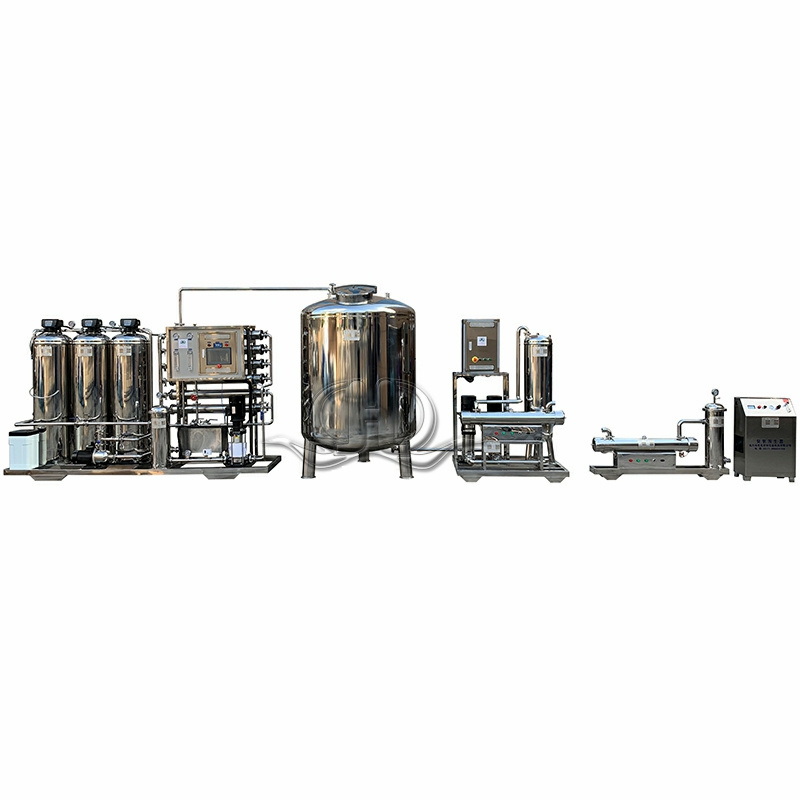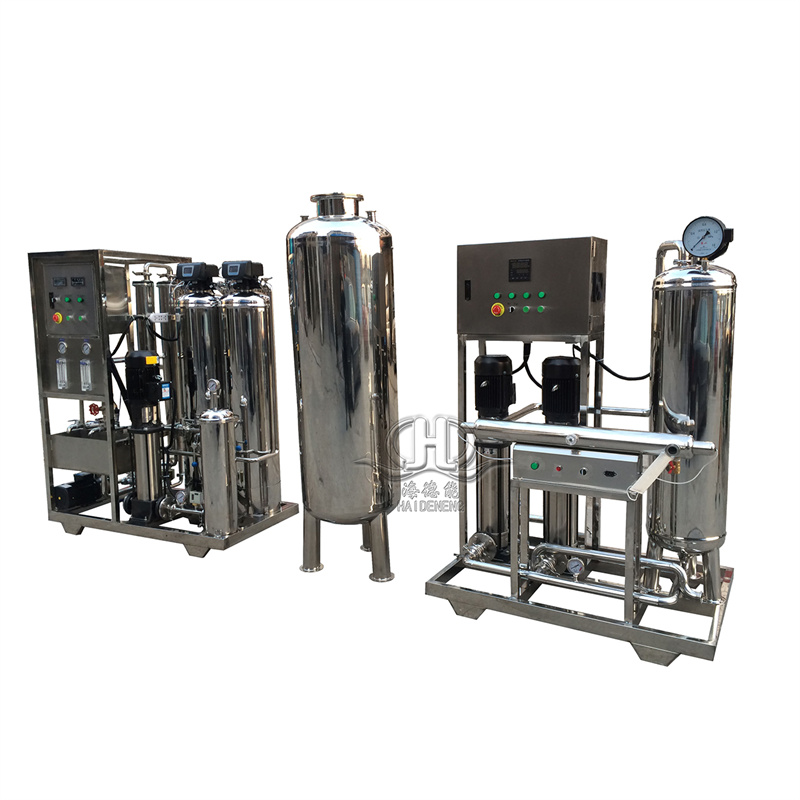Sand Filter Carbon Filter Belt Softening Fully Automatic Fine Filtration Water Quality Pretreatment Equipment
Product description
1、 Equipment system composition and functional architecture
This device is an integrated water quality pretreatment system that uses a multi-stage process of “physical filtration adsorption purification ion exchange precision interception” to remove suspended solids, organic matter, hardness, and fine particles from raw water, providing high-quality inlet water for subsequent deep treatment (such as reverse osmosis and ion exchange). The core components include:
Automatic Sand Filter
Function: Utilizing the physical interception effect of quartz sand, remove large particle impurities such as sediment, rust, colloids, etc. from raw water, and reduce turbidity to ≤ 5NTU.
Automated control: PLC monitors pressure difference (>0.05MPa) or triggers backwashing at regular intervals, using “air-water combined backwashing” (air backwashing intensity 15L/(m ² · s), water backwashing intensity 8L/(m ² · s)), lasting for 10-15 minutes, without the need for manual operation.
Automatic Carbon Filter
Function: Remove residual chlorine (removal rate>99%), organic matter (such as humic acid, pesticides), and abnormal odors through activated carbon adsorption, protecting subsequent membrane components from oxidative damage.
Filter characteristics: Coconut shell activated carbon has a specific surface area of ≥ 1000m ²/g, iodine adsorption value of ≥ 800mg/g, contact time of ≥ 15 minutes, and residual chlorine in the effluent of ≤ 0.1mg/L.
Softening Unit
Function: Using ion exchange resin (such as Na type strong acid resin) to remove calcium and magnesium ions, reducing the water hardness from 300mg/L (calculated as CaCO3) to ≤ 5mg/L, and preventing subsequent equipment scaling.
Regeneration mechanism: Dual triggering of flow/time (such as every 100m ³ of water treated or 72 hours of operation), regeneration using 8% -10% NaCl solution, salt consumption ratio ≤ 1:1.2, regeneration cycle of about 90 minutes.
Automatic Fine Filter
Function: As the last line of defense for pre-treatment, a 5 μ m PP melt blown filter or folding filter is used to intercept fine particles (such as colloids and microbial debris) remaining after sand/carbon filtration, ensuring that the SDI (pollution index) of the influent is ≤ 5, meeting the requirements for reverse osmosis membrane influent.
Replacement logic: Automatic alarm and replacement of filter element when pressure difference>0.1MPa or operation for 1-3 months.
2、 Process flow and water quality progression
plaintext
Raw water → sand filter (to remove large particles) → carbon filter (to remove residual chlorine/organic matter) → softening device (to remove hardness) → precision filter (to remove fine particles) → subsequent deep treatment (such as RO, EDI)
Turbidity (NTU), residual chlorine (mg/L), hardness (CaCO3, mg/L), particle diameter (μ m), SDI value during the processing stage
Raw water ≤ 20 ≤ 1.0 ≤ 500 ≤ 100 ≥ 6
After sand filtration, ≤ 5 ≤ 0.5 ≤ 500 ≤ 50 4-6
After carbon filtration, ≤ 3 ≤ 0.05 ≤ 500 ≤ 10 3-5
Softened ≤ 3 ≤ 0.05 ≤ 5 ≤ 10 3-5
After precision filtration, ≤ 1 ≤ 0.05 ≤ 5 ≤ 5 ≤ 5
3、 Core technological advantages
Fully automated collaborative operation
Sand filter/carbon filter backwashing and softening regeneration are executed in a staggered manner to avoid sudden drops in system flow; The precision filter is linked with the subsequent high-pressure pump to automatically reduce the pump frequency and protect the membrane components when the filter element is clogged.
Support remote monitoring (Modbus protocol), real-time display of pressure, flow, and water quality data of each unit, automatic alarm in case of faults (such as triggering regeneration program when the hardness of softened water exceeds the standard).
Optimization of filter media and anti pollution design
Sand filter: using graded quartz sand (upper layer 0.8-1.2mm, lower layer 0.5-0.8mm) to form a “coarse on top and fine on bottom” filter layer, improving the interception capacity, and the filter material loss rate is less than 5% per year.
Carbon filter: A dome shaped water distributor is installed at the bottom to avoid adsorption blind spots caused by water flow deviation. The activated carbon filling density is 800-1000kg/m ³, and the adsorption cycle is extended to more than 12 months.
Energy saving and environmentally friendly design
The backwash water consumption is ≤ 2% (about 5% for traditional equipment), and the softening and regeneration salt consumption is reduced by 15% compared to the industry average; The precision filter adopts a quick opening head, reducing the filter element replacement time to 10 minutes per group.
The equipment material is Q235B anti-corrosion coating (for water contact parts) or 304 stainless steel, which complies with the GB/T 19249-2017 “Reverse Osmosis Water Treatment Equipment” standard to avoid secondary pollution.
4、 Application scenarios and adaptation to water quality
Industrial pre-processing scenarios
Reverse osmosis pretreatment: provides inlet water (SDI ≤ 5, turbidity ≤ 1NTU) for RO systems in the electronics and pharmaceutical industries, extending membrane life by more than 30% (such as pre-treatment of RO systems in semiconductor factories).
Boiler feedwater: Softened hardness ≤ 0.03mmol/L to prevent scaling of high-pressure boilers (such as pre-treatment of boiler feedwater for 300MW thermal power units).
Circulating cooling water: removes suspended solids and hardness, reduces concentration factor to 3-5 times, and reduces wastewater discharge (such as in chemical park circulating water systems).
Civil and Municipal Scenarios
Pre treatment of direct drinking water in residential areas: Combined with subsequent ultrafiltration/RO, the produced water meets the GB 5749-2022 “Sanitary Standards for Drinking Water” and is used for quality water supply in direct drinking water stations or pipelines.
Rural drinking water renovation: Treat high turbidity and high hardness groundwater (such as in North China), with effluent turbidity ≤ 1NTU and hardness ≤ 50mg/L, to solve scale and sensory problems.
Special water quality treatment
High turbidity surface water: When the turbidity of the raw water is greater than 100NTU, a pre coagulation dosing device (such as PAC) can be used to reduce turbidity in conjunction with sand filtration.
High residual chlorine water source: Install a sodium bisulfite dosing system (ORP control ≤ 200mV) before carbon filtration to prevent excessive oxidation and loss of activated carbon.
5、 Maintenance and Fault Management
1. Regular maintenance plan
Component maintenance content cycle
Check the loss of filter material in the sand filter and replenish quartz sand every six months
Carbon filter detects the adsorption capacity of activated carbon and replaces the filter material every 1-2 years
Softening resin testing exchange capacity, regeneration/replacement every 2-3 years
Replace the filter element of the precision filter and check the aging of the sealing ring every 1-3 months
Control system calibration sensors, backup program quarterly
2. Common troubleshooting solutions
Possible causes and solutions for the fault phenomenon
The turbidity of the sand filter effluent exceeds the standard. The filter material is compacted/not thoroughly backwashed. Strengthen backwashing and supplement the filter material
Excess residual chlorine in the filtered water from the charcoal filter leads to activated carbon failure/short circuit in the water flow. Replace the activated carbon and check if the water distributor is blocked
Softened water with excessive hardness, resin failure/abnormal regeneration program, resin replacement/reset regeneration parameters
The pressure difference of the precision filter suddenly rises, and the filter element is blocked/the raw water is suddenly contaminated. Replace the filter element immediately and check the upstream water quality
6、 Selection and configuration suggestions
Select based on water production rate
Small scale system: 1-10m ³/h (laboratory, small factory), covering an area of 5-8 square meters, with a power of 3-5 kW;
Medium sized system: 20-50m ³/h (residential area, food factory), covering an area of 10-15 square meters, equipped with a 50m ³ intermediate water tank, with a power of 8-15kW;
Large scale system:>100m ³/h (industrial park), multiple sets of equipment connected in parallel, using PLC centralized control, occupying an area of 30-50 square meters.
Targeted configuration of raw water quality
High hardness water (>500mg/L): The softening device adopts two-stage series connection or uses macroporous strong acid resin, and the regenerated salt consumption is increased to 100g/L resin;
High organic matter water (COD>100mg/L): An ozone oxidation unit (O3 dosage of 1-3mg/L) is added before the carbon filter to decompose high molecular weight organic matter and extend the life of activated carbon;
Iron and manganese containing water (Fe>0.3mg/L): The sand filter is replaced with manganese sand filter material (MnO ₂ content>35%), while aeration oxidizes Fe ² ⁺ to Fe ³ ⁺ to improve removal efficiency.
Intelligent upgrade options
Install online water quality instruments (turbidity, residual chlorine, hardness, SDI) to achieve real-time monitoring of the entire process;
Integrating AI algorithms to automatically adjust backwash frequency and regeneration cycle based on fluctuations in raw water quality, optimizing chemical consumption (such as reducing salt consumption by 10% -15%).
summarize
This pretreatment equipment achieves efficient purification of raw water through the full process design of “sand filtration carbon filtration softening fine filtration”, especially suitable for reverse osmosis pretreatment, boiler water replenishment, and municipal water supply scenarios with strict requirements for inlet water quality. Its core value lies in its high degree of automation, long lifespan of filter media, and low operating costs. Through flexible configuration, it can adapt to different challenges of raw water quality and is a key pretreatment solution in the fields of industrial and civil water treatment.






